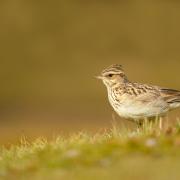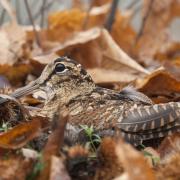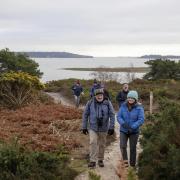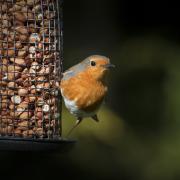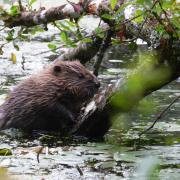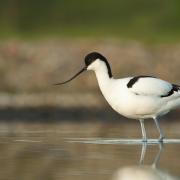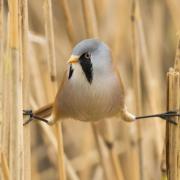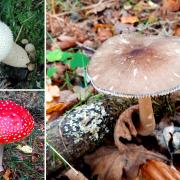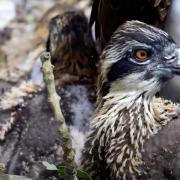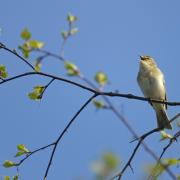The British public recently voted Brownsea Island as the nation’s favourite nature reserve. Adam Lee-Potter, who has fond childhood memories of visiting the island, meets the people who have helped to make this island in Poole Harbour so special

I first visited Brownsea Island when I was eight years old. And it was a thoroughly Just William affair. After pushing a pal howling into a cess pit, I tried to pluck a tail feather from a passing peacock. I still bear the scar, a wholly deserved welt on the back of my hand.

Inexplicably, I didn’t return for more than 30 years, a pilgrimage prompted when my chum Reuben landed the job as Head Ranger on Brownsea.
But I belatedly realised what nature lovers have long known: Brownsea is a gem. And in January, that status became official as the island was voted, in a poll run by BBC Countryfile magazine, Britain’s favourite nature reserve.
The beauty of Brownsea lies, of course, in its size and position: small enough – just a mile-and-a-half long - to embrace in a day yet magical enough to bewitch for life.
As Reuben, who moved here from London three years ago, his belongings ferried over from the mainland on a flatbed barge ‘The Furzey Squirrel’, says: “Brownsea is special because of the whole package. You get to come by boat – that amazing trip from Poole Quay or Sandbanks. The view from the harbour is second to none.
“And – unlike some bigger, more daunting nature reserves - you can really interact with Brownsea. This is not some stuffy museum set behind glass. It’s incredibly diverse – the lagoon, the woodland, the heath, the beaches. Children love it here because the wildlife is stunning but accessible and obvious – red squirrels, rabbits, Sika deer, peacocks. It’s all cute and cuddly or bright and exciting.”
More than 130,000 people yearly visit the island which, since 1963, has been owned by the National Trust, in partnership with the Dorset Wildlife Trust, which runs the lagoon, and John Lewis, which leases the castle as a hotel for employees.
The National Trust’s Property Manager Angela Cott tells me: “We are so delighted that more people voted for Brownsea than anywhere else but it’s very much a team effort. This place is unique.”
The island is open to the public from February to November. But I have to admit my favourite time of year to visit is out of season when just 29 people – including Reuben, his partner Nanette and their eight-year-old daughter Mathilda – live here.
Brownsea is suddenly transformed into a real-life, island prism of The Archers, a tight unit made up largely of rangers and boatmen. It’s like stepping, very quietly, back in time. The church, shop, café, campsite and castle all close. The beaches are deserted.
Still, this is very much a living community: there are nine children aged between one and 11. Certainly, I can think of few more special places to grow up than on Enid Blyton’s Whispering Island, the 1907 birthplace of Robert Baden-Powell’s scouting movement.
There is even a Home Guard-style fire brigade complete with its own uniform and old engine which can pump water from the two lakes which, until the pipeline was dug eight years ago, also provided the drinking water.
Fire is a real danger. In 1934, a wild blaze caused devastation after burning for a week. Much of the island was reduced to ashes. It is widely claimed that the fire was set by one of the 200 disgruntled islanders – ordered by the reclusive Mary Bonham-Christie to leave when she bought Brownsea for £125,000, the cash, as legend has it, stuffed into plastic bags.
But Bonham-Christie’s resolve was only strengthened. She hired a female Swedish bodyguard, a former Olympic swimmer, with strict orders to turf off any trespassers. It was only when she died in 1961 that her family, crippled by inheritance tax, bequeathed the island – which today costs the National Trust £750,000 a year to run and maintain – to charity.
Eighty years on, fire is no less a risk. In 2012, Brownsea’s firefighters were first in attendance on neighbouring Green Island after the millionaire owner’s new three-storey timber chalet burned to the ground in a suspected electrical fire.
For such a tiny island – its 500 acres dwarfed by Poole Harbour – Brownsea reeks with history dating back to 800BC, as noted by the worthy 1970 tome, Poole Bay and Purbeck, 300BC-AD1660. There is evidence of a Roman settlement, some 800 years later, followed by Saxons. Brownsea – or the archaic Branksea – is a corruption of its old Saxon name, Brunoc’s Island.
What became of old Brunoc is not known but in the 9th century, a hermit from Cerne Abbey took over the island. His role was to nightly light a warning beacon on the shore: England’s first lighthouse.
But no one has ever held onto Brownsea for long as a succession of royals, rogues and eccentrics have scrambled to clutch the island’s grandeur and strategic importance.
As author Donald Maxwell pointed out in his 1927 study, Unknown Dorset: “Branksea Castle, sometimes known as Brownsea, built in the reign of Henry VIII, enlarged and partly rebuilt by Charles I, was the Gibraltar of Poole Harbour, effectively checking the entrance or exit of ships for the purpose of levying toll upon them.”
Nonetheless, one subsequent owner slit his throat in the castle in a fit of depression. Another – a keen patriot – had all the rooms painted red, white and blue.
The Waughs bought the island in the 1850s, building a pottery to harness what they thought was valuable china clay. It wasn’t; they ended up making sewage pipes. They later fled to the continent, leaving behind huge debts.
The village they built for their pottery workers became a decoy in the Second World War. Technicians from Elstree Studios set up tanks of oil, lit to deflect German bombers from Poole.
Then there were the Cavendish Bentincks, who imported statuary from the Mediterranean and even built a pub, The Bentinck Arms, which sadly shut down in the 20s. After them, came the van Raaltes, friends of Baden-Powell who presided over the island’s so-called Golden Age from 1901, running a successful daffodil farm and a dairy herd.
But, ironically, it was Bonham-Christie – dubbed the Demon of Brownsea by the islanders she evicted – who proved not only the most notorious but also the most nurturing.
Under her 34-year tenure, the island simply reverted to nature. Barry Guest, now 74, became her boatman in 1960, just months before her death. He remembers her well.
“I was only 20 and I’d grown up on the water so I wrote to her, asking for a job, and she was very kind to me. She lived in one room of the castle, overlooking the Italian garden and out towards the ferry. I’d go and see her there once a week.
“She was a bit like Queen Victoria in her old age – little and round. And she was eccentric. But she was no demon. If anything, she was an early conservationist. She spent a fortune on the sea wall and all the roofs were sound.
“But she was adamant - doubly so after the fire - that the public should not set foot on her island. And that became my job, to kick them off.
“The old lady knew she wasn’t popular but I don’t think she cared. I remember her once rocking with laughter as she told me: ‘Do you know, gossips in the war said I had a radio up the chimney and was a German spy. All I’d said was that I’d had a German butler once and he was a very efficient man’.”
Barry went on to become Head Warden and, later, Property Manager before retiring 10 years ago, after 43 years on the island. Last year he went back to Brownsea to stay in his old house on the quay – now a holiday cottage. “I quite enjoyed it but you’ve got to move on, haven’t you?” he smiles.
Bonham-Christie’s grandson John inherited Brownsea upon her death and applied for planning permission to build 400 houses as he could see no other way of maintaining the island. He had, however, reckoned without the intervention of Helen Brotherton.
Aware of the island’s potential as a wildlife reserve, she campaigned to defeat the application. Thwarted, John instead gifted Brownsea to the Treasury in lieu of death duties. Government, in turn, passed it on to the National Trust.
But the family seems remarkably unbitter. Clare Bonham-Christie is the widow of Robert, John’s eldest son. “The family is very pleased that the National Trust was able to take it over,” she says. “Of course, it still holds a special place in our hearts. I was there for the 50th celebration last year with my son. But for me, Brownsea is just an era gone by.”
John Bonham-Christie was also instrumental in helping to forge what is arguably one of the island’s most defining characteristics: its 400-strong army of volunteers.
Lewis Parkyn, 71, has served as a volunteer warden for 40 years. Last year, he was awarded the Freedom of Brownsea and a British Empire Medal in honour of his work.
The retired solicitor says: “It was just before 1962 and John had offered to bequeath the island but the National Trust said they could only take it if they could raise an endowment of £100,000. John told them in turn: ‘I don’t think I can cope with the island on my own.’ So the Trust appealed for volunteers to go over and help him, just for one weekend.
“I jumped at the chance. Back then, it was the forbidden island. After the old lady died, people started to land there – I know, I was one of them. We were regularly turfed off by Barry but Brownsea was a magnet and here was a chance to go over with permission. I threw off 200 people myself that weekend but I thought it was a one-off. I didn’t realise that John Bonham-Christie wanted it to carry on.”
Brownsea became very much a family affair for Lewis. His father, mother, wife and both his sons all joined him on the island as volunteer wardens.
“My wife was pregnant back then, so my eldest son Andrew was going to Brownsea before he was even born. I still go over once every three weeks or so to help out. But why not? My father carried out his last wardening duty in his 90th year, I hope to do the same. Doing something worthwhile in the open air and making wonderful friends in a truly special place. What could possibly beat that?”
Indeed. William Brown couldn’t have put it better himself.
----------------------------------------------------------------
Reserve of the month
The chatter of nesting terns on the lagoon and the scurrying of red squirrels in the woodland are just some of the wildlife-rich sounds you will hear on Brownsea Island, which is owned by the National Trust. Dorset Wildlife Trust (DWT) leases part of the island, (101 hectares) and have managed the nature reserve for over 50 years now. Both partners were delighted that the island has been awarded ‘Britain’s favourite nature reserve’ by BBC Countryfile magazine. And it’s not hard to see why it is so popular.
Few of our wildlife species have such immediate appeal as the red squirrel, with its chestnut colouring, bushy tail and tufted ears. It has become an iconic image of the island. The patient and determined are usually rewarded with a sighting of these spectacular creatures – particularly on the feeding stations at DWT’s visitor centre at The Villa, which always has a good supply of nuts!
Winter is a particularly good time to see other wildlife on the island, including flocks of avocets and black-tailed godwits, which visit the lagoon in nationally and internationally important numbers. State-of-the-art bird hides allow wildlife enthusiasts front-row seats to a fantastic spectacle: thousands of flocking wading birds. Even to the novice, it is an impressive and unique sight.
It is hard to believe that once, the wildlife on Brownsea Island was under threat from invasive rhododendron; suffocating wild flowers and trees and threatening the survival of one of the last remaining red squirrel populations in southern England. DWT reserve manager for Brownsea, Chris Thain, said: “It is estimated that the equivalent of 48 football pitches of this invasive plant have been cleared over the decades by an army of 10,000 dedicated volunteers. In September 2011, the last cut was made to clear the nature reserve completely of it.”
The hard work of volunteers will enable indigenous growth to re-establish itself and provide a better habitat, not just for the red squirrels, but other wildlife too. “We are pleased to see new species being recorded,” said Chris. “In 2013 we recorded 950 different types of beetles, and over 740 species of butterflies and moths,” he added.
Brownsea Island nature reserve has captured the hearts of those who visit, including wildlife film maker and president of the Wildlife Trusts, Simon King, who opened the newly restored Macdonald hide in 2011.
“Among Dorset’s many natural gems, Brownsea Island is a real diamond,” said Simon. “It hosts a wealth of wildlife in any season, from the great flocks of avocets in winter, to charming red squirrels all year round. All in all, an atmosphere of splendid isolation,” he added.
All the action on the lagoon is recorded 365 days a year on the webcam, in partnership with Birds of Poole Harbour and the National Trust, so viewers can watch the bird species come and go, day and night. To watch the webcam go to: dorsetwildlifetrust.org.uk/brownsea_island_nature_reserve.html. Sally Welbourn
***
Get Involved
Join Brownsea Island’s volunteers.
9 & 23 March (alternate Sundays all year) Brownsea Island Work Party
Join the regular volunteering group. Tasks include pine thinning, opening out the alder carr and rhododendron cutting. Starts 9.30am. For details of boat timings contact Richard Proctor on 01202 693039 or 07718 511432.
For more information about visiting the DWT reserve visit: dorsetwildlifetrust.org.uk/brownsea_island_nature_reserve or call 01202 709445.
***
About Brownsea Island
The National Trust owns Brownsea Island, which covers some 500 acres. They directly manage around 60% of it – including heath, grassland, beaches, cliffs, pine and broadleaf woodland, ponds and campsite. A little under 40% is leased to Dorset Wildlife Trust (DWT). This includes the lagoon, lakes, salt marsh and reed beds as well as the wetland area around the Villa with the bird hides. The remaining 18 acres is leased to the John Lewis Partnership (JLP) who manage a hotel for John Lewis staff (in Brownsea Castle) and its gardens (there is no public access).
All three organisations work very closely together to help run the island. “The whole island is a nature reserve,” says Reuben Hawkwood, who is Head Ranger on Brownsea. “Everyone is thrilled with the Countryfile award. It reflects the great day out we offer - the excitement of the boat trip over, the warm welcome upon arrival, the many events and activities on the island, the wildlife, the habitats, the friendly people and the incredible setting.”
***
Getting there…
Brownsea is open at weekends from 9 Feb – 16 March (10am to 4pm). Boats every 30 mins from Sandbanks only (£6/£4). Open daily 23 March - 2 Nov (10am to 5pm), boats every half hour from 10am at Sandbanks Jetty (BH13 7QJ) or Poole Quay (£10/£6) (BH15 1HP). Admission to Brownsea: Adult £6.60/ Child £3.30/ Family (2 adults and up to 3 children) £16.50/NT Members Free. DWT members show membership card to visit DWT area.
***
Events on Brownsea Island
30 March: Mother’s Day - Decorate a free biscuit for your Mum in the Villano café and have a cream tea.
10 -11 April: World War One Walk - Explores the island’s war connections. 11am Booking essential 01202 707744
12 April: The Big Den Build - Learn how to build a shelter (11am -1pm; 2-4pm). Booking essential 01202 707744
18 -21 April - Easter Fun: Face painting, games, arts, crafts and Easter egg trail (10am -4pm)
More deails at nationaltrust.org.uk/brownsea-island or call 01202 707744.








